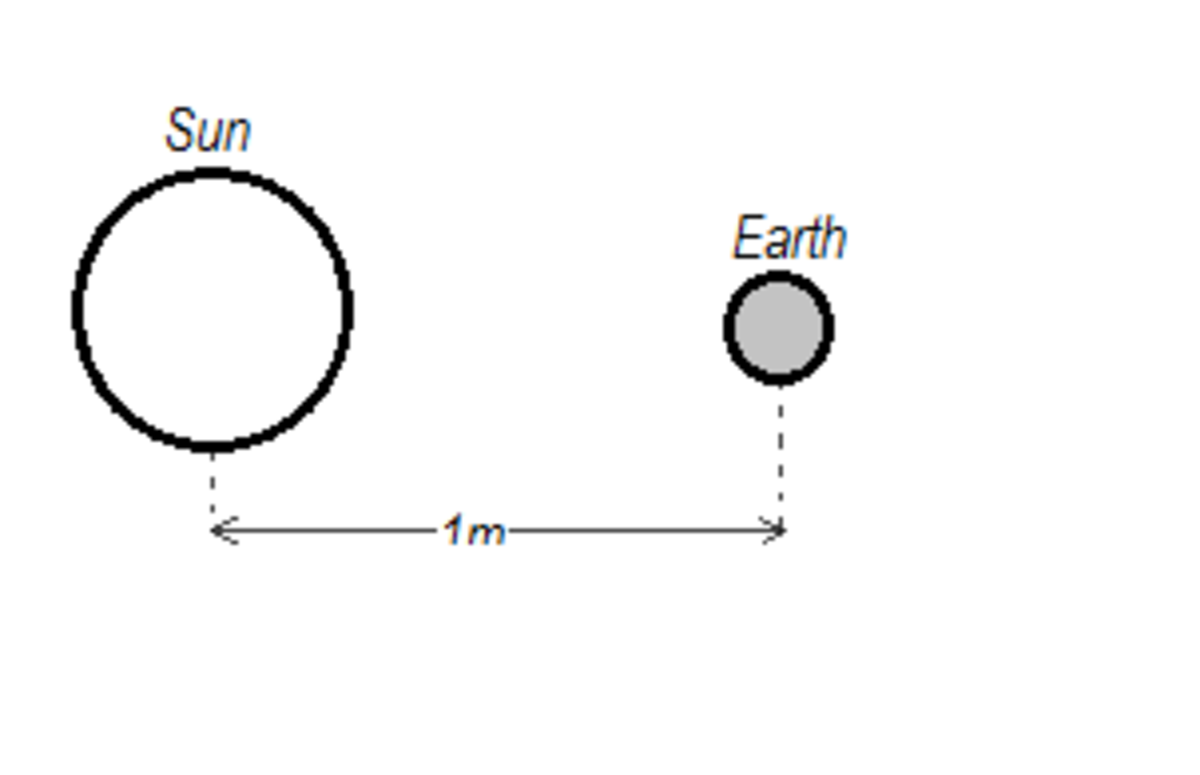Shrinking the Solar System

If the solar System were proportionally reduced so that the average distance between the Sun and the Earth were 1m, how long would a year be? Take the density of matter to be unchanged. Answer in days.
The answer is 365.
This section requires Javascript.
You are seeing this because something didn't load right. We suggest you, (a) try
refreshing the page, (b) enabling javascript if it is disabled on your browser and,
finally, (c)
loading the
non-javascript version of this page
. We're sorry about the hassle.
2 solutions
Equate the forces of attraction between the Sun and the Earth to the centripetal force that keeps the Earth in its approximately circular orbit, and express the angular velocity ω in terms of T , the period of revolution. This gives - r 2 G m M = m r ω 2 = m r T 2 4 π 2 where m and M are the respective masses of the Earth and Sun, and r is the average distance between them. Divide by m and express M in terms of the average density ρ and radius R of the Sun as follows:
G r 2 3 4 π R 3 ρ = T 2 4 π 2 r T h i s y i e l d s , T = G ρ 3 π ( R r ) 3 f o r t h e p e r i o d o f r e v o l u t i o n .
It can be seen that the Earth's rotation period only depends on universal gravitational constant G , the average density of the Sun ρ and the ratio R r . Therefore if the density of matter remains constant, any scaling of the solar system leaves the length of the year unchanged. It can also be seen that only the density and the size of the Sun are relevant. Any body that is small in size relative to the sun would have the same period and follow the same orbit.
This gives the answer to be 3 6 5 days
Nice q.I did it as T = 2 π L ( 3 / 2 ) / √ G M where M is the mass of sun.As the scales are being reduced by earth sun distance(Lo)We have M = M o / L 3 So T = T o L ( 3 / 2 ) = 3 6 5 days
@Spandan Senapati that's a good way out... Easy way...
Log in to reply
Hey in the other prob what do you mean by receiving the max possible fraction????It must be f = K ( f i n a l ) − K ( i n i t i a l ) / K ( T o t a l ) .Because we need to find the fraction "received".Solving this way the ratio was 2 − √ 3 ...And the next statement altogether puts into confusion as v = ( 3 y − 1 ) / ( y + 1 ) . y = m ( 2 ) / m ( 1 ) and this function is strictly increasing.Kindly clarify.K(final)is the final KE of the upper body.
@Spandan Senapati we have to take the kinetic energy after the collision.. it is k m1 / (k m1 + k M2) after the collision... And more is k m1 the higher it rises up... For that we have to find the ratio...
Log in to reply
OK I got it right now.I was probably confused by the meaning of "recieved".But again one mistake ratio of m ( 1 ) / m ( 2 ) for which f is max doesn't ensure maximum height.As in the previous comment I mentioned that the function for height is strictly decreasing..To be more sound mathematically the fraction ( f ) = x ( x − 3 ) 2 / ( x + 1 ) 3 .But height is given by H = H ( o ) ( x − 3 ) 2 / ( x + 1 ) 2 . f has an optimum at x = 1 / 3 = 0 . 3 3 3 ...but not H .So kindly update the problem.I hope you got it. x = m ( 1 ) / m ( 2 )
Log in to reply
Oh actually, when I solved the problem, I got three possible values of ratio 1, 1/3 and 3 now m1 must be smaller than m2 so I took 1/3. And I took it for granted that it will reach the maximum height when it will have the max possible kinetic energy after the collision...
For a simplistic analysis, assume that the Earth is in uniform circular motion about the Sun:
R o r b i t 2 G M S u n = R o r b i t v o r b i t 2 = R o r b i t ω o r b i t 2 G M S u n = R o r b i t 3 ω o r b i t 2 G 3 4 π R S u n 3 ρ = R o r b i t 3 ω o r b i t 2
If the solar system shrinks uniformly, both R S u n and R o r b i t will shrink by the same proportion, and each side of the above equation is proportional to the cubic power of its respective "R" value. Therefore, ω o r b i t will remain unchanged after the solar system shrinks. Assuming that the change in the solar system scaling has no effect on the speed of the Earth's rotation about it's own axis, there will still be 365 days in a year.